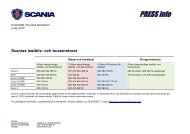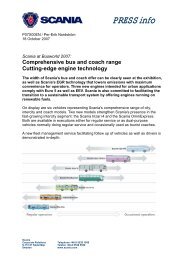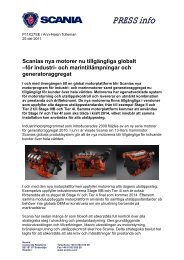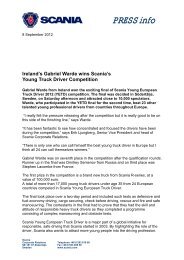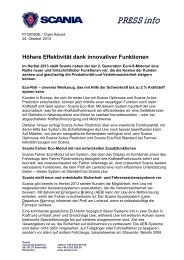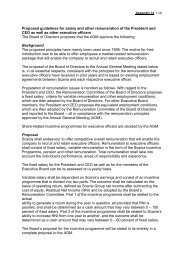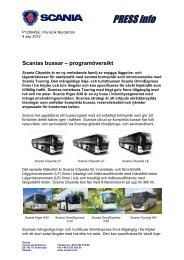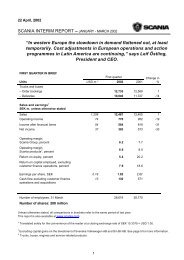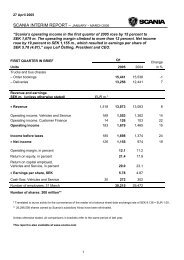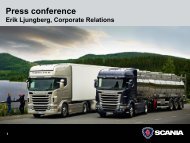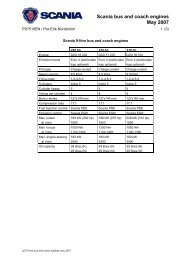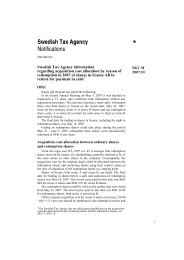Scania Annual Report 2011
Scania Annual Report 2011
Scania Annual Report 2011
You also want an ePaper? Increase the reach of your titles
YUMPU automatically turns print PDFs into web optimized ePapers that Google loves.
87<br />
balance sheets of foreign subsidiaries are translated to the Group’s<br />
reporting currency, Swedish kronor. All items in the income statements<br />
of foreign subsidiaries are translated using the average exchange<br />
rates during the year. All balance sheet items are translated using<br />
the exchange rates on the balance sheet date (closing day rate). The<br />
translation differences that arise when translating the financial statements<br />
of subsidiaries outside Sweden are recognised under “Other<br />
comprehen sive income” and accumulate in the currency translation<br />
reserve in equity. Subsidiaries use the local currency as their functional<br />
currency, aside from a few subsidiaries for which the euro is the<br />
functional currenc y.<br />
Monetary long-term items in a business outside Sweden for which<br />
settlement is not planned or will probably not occur within the foreseeable<br />
future are, in practice, part of the company’s net investment<br />
in opera tions outside Sweden. Exchange rate differences on such<br />
monetary items, which comprise part of the company’s net investment<br />
(extended investment) are recognised under “Other comprehensive<br />
income” and accumulate in the currency translation reserve in equity.<br />
Hyperinflationary economies – adjustment of financial reports<br />
Inflation adjustment of financial reports occurs for operations with a<br />
functional currency that is the currency of a hyperinflationary country.<br />
At present, none of the Group’s subsidiaries has a functional currency<br />
that is regarded as a hyperinflationary currency.<br />
Operating segment reporting<br />
An operating segment is a component of the company that generate s<br />
revenue and incurs expenses and whose operating results are<br />
reviewe d by the Board of Directors and the Executive Board.<br />
The operations of the <strong>Scania</strong> Group are managed and reported<br />
on the basis of two operating segments, Vehicles and Services plus<br />
Financial Services. These two segments have distinct products and<br />
differentiated risk situations. The tied-up capital and accompanying<br />
financing structure in Financial Services differ substantially from their<br />
equivalents at Vehicles and Services. Internal reporting at <strong>Scania</strong> is<br />
designed in accordance with this division into operating segments.<br />
Finan cial expenses and taxes are reported at the segment level in<br />
orde r to better reflect the operating segments. The Vehicles and<br />
Services operating segment encompasses trucks, buses and engines,<br />
including the services associated with these products. All products are<br />
built using common basic components, with coordinated development<br />
and production. In addition, the Vehicles and Services operating segment<br />
is organised under common areas of responsibility.<br />
The Financial Services operating segment encompasses financial<br />
solutions for <strong>Scania</strong> customers, such as loan financing, lease contracts<br />
and insurance solutions. The assets of this operating segment encompass<br />
the assets that are directly used in its operations. Correspondingly,<br />
the operating segment’s liabilities and provisions refer to those that are<br />
directly attributable to its operations.<br />
BALANCE SHEET – CLASSIFICATIONS<br />
<strong>Scania</strong>’s operating cycle, that is, the time that elapses from the purchase<br />
of materials until payment for goods delivered is received, is<br />
less than twelve months. This means that operations-related items are<br />
classified as current assets and current liabilities, respectively, if these<br />
are expected to be realised/settled within twelve months, counting<br />
from the balance sheet date. Cash and cash equivalents are classified<br />
as current assets unless they are restricted. Other assets and liabilities<br />
are classified as non-current. For classification of financial instruments,<br />
see the section on financial assets and liabilities under “Recognition of<br />
financial assets and liabilities”, page 88.<br />
Classification of financial and operating leases (<strong>Scania</strong> as lessor)<br />
Lease contracts with customers are carried as financial leases in cases<br />
where substantially all risks and rewards associated with ownership of<br />
the asset have been transferred to the lessee. At the beginning of the<br />
leasing period, sales revenue and a financial receivable equivalent to<br />
the present value of future minimum lease payments are recognised.<br />
As a result, the difference between the sales revenue and the cost of<br />
the leased asset is recognised as income. Lease payments received<br />
are recognised as payment of the financial receivable and as financial<br />
revenue.<br />
Other lease contracts are classified as operating leases and are<br />
carrie d as lease assets among tangible non-current assets. Revenue<br />
from operating leases is recognised on a straight-line basis over the<br />
leasing period. Depreciation of the asset occurs on a straight-line basis<br />
to the estimated residual value of the asset at the end of the leasing<br />
period.<br />
Transactions that include repurchase obligations or residual value<br />
guarantees, which mean that important risks remain with <strong>Scania</strong>, are<br />
carried as operating leases; see above.<br />
Lease obligations (<strong>Scania</strong> as lessee)<br />
In case of a financial lease, when the risks and rewards associated with<br />
ownership have been transferred to <strong>Scania</strong>, the leased asset is carried<br />
as a tangible non-current asset and the future commitment as a lia bility.<br />
The asset is initially carried at the present value of minimum lease<br />
payments at the beginning of the leasing period. The leased asse t<br />
is depreciated according to a schedule and the lease payments are<br />
recognised as interest and principal payments on the liability. Operating<br />
leases are not carried as assets, since the risks and rewards associated<br />
with ownership of the asset have not been transferred to <strong>Scania</strong>.<br />
Lease payments are expensed continuously on a straight-line basis<br />
over the lease term.<br />
financial reports <strong>Scania</strong> <strong>2011</strong>



